It can melt the shells of the tiny snails that, at times, make up half the diet of juvenile salmon, pollock, herring and cod in the North Pacific. It can halt the growth of the protective armor on microscopic plankton found in such abundance that they make the sea appears aqua blue from outer space.
It could help destroy Earth’s coral reefs—where a quarter of all the organisms in the ocean spend at least part of their lives, and which are a living resource for 300 million people.
“We’re talking about tiny marine plants and animals—that larger organisms depend on—being affected from the tropics to temperate and arctic waters. We can see this as a worldwide problem,” says Richard Feely, a University of Washington affiliate professor of oceanography.
Another doomsday scenario because of global warming? Not exactly. While human-made carbon dioxide is the cause, Feely is not blaming higher temperatures alone for this nightmare. Instead he’s talking about ocean waters becoming more acidic, a process called ocean acidification.
Unlike climate change—which can reveal itself in varied ways, including making some places colder—ocean acidification is a straightforward response of seawater to excess carbon dioxide, says Oceanography Professor James Murray, the founding director of the University’s Program on Climate Change. While the debate continues on how much global warming is human-caused, there is no quarrel over changing ocean chemistry. Oceanographers agree that ocean acidification is the result of carbon dioxide generated since the Industrial Revolution. In the past 200 years, the oceans have absorbed about 525 billion tons of carbon dioxide from the atmosphere, nearly half of all fossil-fuel emissions.
“The predictions point to a dire state of affairs. The whole marine food web could be affected.”
James Murray, oceanography professor
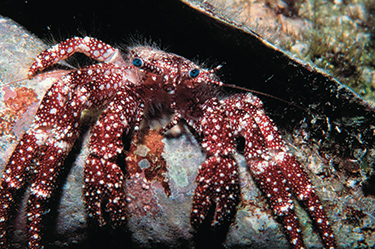
Threatened by rising levels of carbon dioxide in the oceans: white speckled hermit crab. Photo by Paige Gill.
If you can estimate how much excess carbon dioxide humans will put into the atmosphere in coming years, then scientists can tell you how much ocean acidification to expect. “The predictions point to a dire state of affairs,” Murray says. “The whole marine food web could be affected.”
As human-made carbon dioxide gas dissolves into seawater, it threatens the shells, protective coatings and skeletons of tiny organisms. These organisms use substances in the water to build and maintain their “armor and bones” in a process called calcification. If the ocean chemistry changes enough, they can become weak and even shell-less.
In addition, larger organisms are in danger. Oyster and mussel shells can thin. The latest work shows some types of crabs are also affected. Even organisms that don’t depend on calcification appear susceptible. Acidification of seawater triggers changes in the size of fish egg sacs and eggs, and causes mortality rates of 60 percent to 80 percent in a variety of fish species when they are in their vulnerable larval form.
At present, the chemistry of the oceans is changing at least 100 times more rapidly than it has during the 650,000 years preceding our industrial era, wrote Feely and colleagues last year. “If current carbon dioxide emission trends continue, computer models show that the ocean will continue to undergo acidification to an extent and at rates that have not occurred for tens of millions of years.”
Haven’t heard about ocean acidification? You’re not alone.
While some scientists realized in the 1970s that excess carbon dioxide gas could change ocean chemistry, the phrase “ocean acidification” was only coined in 2003. It wasn’t until 2004 that two definitive papers on the subject appeared in Science and 2006 that a blue-ribbon panel of scientists compiled the most complete report on the subject.
The oceanographic community has been building the evidence about the change for decades, and UW faculty, affiliate faculty and students have played key roles. Just last year the UW’s 276-foot research vessel, the Thomas G. Thompson, carried scientists from Tahiti to Alaska so they could duplicate an ocean chemistry survey in the Pacific done 15 years before, yielding more evidence of the changes under way.
And it may be that the UW’s Friday Harbor Laboratories is a prime place to start nailing down what we don’t know, such as how ocean acidification might affect marine communities and ecosystems as a whole.
Different species will take the place of any that are displaced or disappear. But are we really ready to accept the changes that might occur?
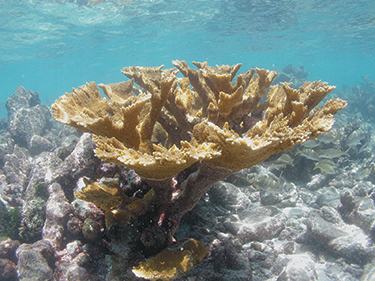
Elkhorn coral. Photo by Jeff Anderson, courtesy of Florida Keys National Marine Sanctuary.
We’re not going to kill everything in the oceans, scientists are quick to say. The oceans will adapt. Different species will take the place of any that are displaced or disappear. But are we really ready to accept the changes that might occur? No coral reefs? No Pacific Northwest salmon because they’ve been forced to take up residence someplace else?
Feely recalls the first time he saw the potential effects of ocean acidification on ocean life. In the mid-’80s, he was leading expeditions in the North Pacific making surveys of ocean chemistry. On the recommendation of a colleague, he invited biology graduate student Victoria Fabry, now a faculty member at California State University at San Marcos, to join the expedition.
In the lab on that cruise, Fabry subjected tiny snails called pteropods to water with high amounts of dissolved carbon dioxide. Pteropods have crystal clear, jewel-like shells in various shapes and often are the escargot of choice for juvenile salmon and other fish. The scientists watched with surprise as the shells of living animals turned opaque and then began to dissolve.
With ocean acidification it’s not as if everything is starting to swim around in acidic lemon juice, like a cod fillet on a dinner plate. Rather, excess carbon dioxide has changed the balance and proportions of the chemical soup naturally found in the oceans.
As carbon dioxide dissolves into seawater it produces carbonic acid. This acid on its own doesn’t attack the shells and skeletons of sea life. Rather, the carbonic acid begins splitting apart and recombining with other atoms and molecules in seawater. The process uses up some of the essential building blocks of sea life. There is less available for organisms that require carbonate and calcium to build their armor and skeletons. And once built, there has to be enough carbonate and calcium in the water to maintain the protective coverings and skeletons—or else they begin to dissolve.
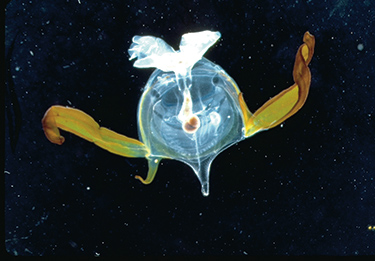
Cavolinia tridentata, Photo by Victoria Fabry.
Feely started publishing his findings in the 1980s, but just as some dismissed early reports of global warming, his theory proved contentious. Some scientists said it was just a North Pacific problem. Others said it would be difficult to determine how much human-made carbon dioxide was actually ending up in the oceans.
It took almost two decades for Feely and colleagues to answer. In his office at the National Oceanic and Atmospheric Administration’s Pacific Marine Environmental Laboratory—Feely is a NOAA oceanographer as well as a UW faculty member—he pulls out a copy of a 2004 Science magazine article, of which he was lead author.
“These are some of the most important plots of my career,” he says.
The three figures show the changes in the carbon chemistry of the Atlantic, Indian and Pacific oceans since the beginning of the Industrial Revolution. It took years, but after a number of worldwide survey programs were completed, Feely and his team used the resulting data to develop the plots that clearly showed this was a global problem.
What’s worse, the effect is not distributed evenly from the top to the bottom of the oceans. A good half of human-made carbon dioxide is in just the upper 10 percent of ocean waters because the oceans turn over very slowly.
“What we showed here,” he says, pointing to the plots, “is that this human-caused carbon dioxide was affecting where calcium carbonate was beginning to dissolve, where the shells would begin to dissolve. As more of that carbon dioxide is absorbed, this transition zone has moved closer and closer to the surface.”
Plants must be in the upper waters in order to get the sunlight they need, and many animals go there to feed. The well-known coral reefs in the tropics are all in shallow water. Some of the organisms, such as the corals, are fixed to hard surfaces and can’t simply move away from the carbon dioxide-enriched waters.
Just how much harm might result is the big question. Scientists are still trying to sort out the possible detrimental effects on individual species of calcifying organisms.
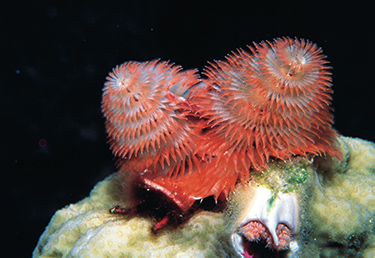
Spiral gilled tube worms. Photo by Paige Gill, courtesy of Florida Keys National Marine Sanctuary.
Take, for instance, the single-cell plant-like organisms called coccolithophores. Along with others, they are a foundation of the ocean’s food web, especially in nutrient-poor waters where coccolithophores can thrive but phytoplankton do not.
Coccolithophores use carbonate and calcium to cover themselves with plates, sometimes more than 100 of them. The plates may offer the cells some sort of protection, according to Peter von Dassow, ’97, who did post-doctoral research in the lab of Oceanography Professor Virginia Armbrust and is now at France’s Station Biologique de Roscoff. Or they may concentrate carbon dioxide for photosynthesis. Or perhaps the plates act like light filters or collectors to modulate the light that gets into the cell.
“We don’t know exactly why having calcite plates is good for coccolithophore cells. They must provide some sort of advantage because these tiny plant-like cells have evolved a very complex machinery to produce such ornamentation—which they seem to regulate very carefully—and they are a very successful group of phytoplankton,” von Dassow says.
“We think that calcification by coccolithophores has played a key role in ocean biogeochemistry and, hence, carbon cycling, since they first appeared about 220 million years ago,” von Dassow adds. “So a change in calcification by coccolithophores, and a change in their ecology, might have a big impact on the ocean.”
Suppose higher levels of dissolved carbon dioxide cause protective coatings to degrade but the animals don’t die. Will they be eaten by new predators if their armor isn’t as strong? Can they still reproduce in the same abundance? Can they still compete as well with other organisms for food? If they disappear, what else might take their place in the food web?
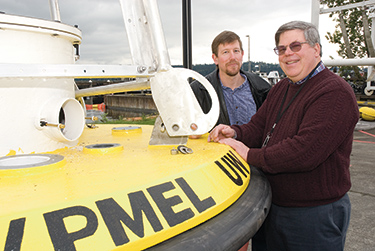
Affiliate UW Professors Chris Sabine (left) and Richard Feely inspect a marine buoy at the Pacific Marine Environmental Laboratory. The two NOAA researchers were among the first scientists to warn about rising carbon dioxide levels in the oceans. Photo by Mary Levin.
With these questions looming, it is time to study ocean acidification across whole ecosystems and in the open ocean. Scientists think UW’s Friday Harbor Laboratories would be an ideal setting. They want to capture mini-ecosystems in specialized plastic bags that are about 7 feet by 17 feet in size, what are called “mesocosms.” Researchers scoop water into the bag along with all the diversity of plants and animals in that particular water sample so that the community can be subjected to various experiments.
The waters of the San Juan Islands are filled with the kind of pteropods that were the subject of those shipboard experiments in the 1980s, when their shells dissolved in waters containing concentrated carbon dioxide.
“The North Pacific is an area we think is particularly vulnerable,” says Chris Sabine, NOAA oceanographer and UW affiliate assistant professor. Not only is human-made carbon dioxide gas dissolving into the oceans at the surface in the North Pacific, but this area also receives carbon dioxide that has accumulated naturally in deep waters over in the Atlantic around Greenland and Iceland. Those deep waters travel slowly around the globe, ending up on our doorstep just as the forces driving global ocean circulation push the carbon-dioxide-rich waters back toward the surface.
“As man-made CO2 comes in from the top it meets the high natural CO2 that’s coming up from the bottom,” Sabine says. “Projections in model studies have suggested that by the end of this century these two can interact in a way that the North Pacific will actually become corrosive to the shells of these organisms, something that hasn’t happened in millions of years.”
The rising cost of gas
Considering how vast the oceans are, just how is it that humans have managed to change their chemistry?
People have no idea how much carbon dioxide we generate, says Chris Sabine, a NOAA oceanographer and affiliate assistant professor at the UW. Sabine has played a key role in recent years on the team pulling together measurements of carbon dioxide in the world’s oceans from dozens of groups around the world—there were 12 labs in the United States alone—that had participated in global surveys of ocean chemistry. After five years of work, Sabine was the lead author of a 2004 paper in Science that quantified just how much human-made carbon dioxide has gone into the oceans since the Industrial Revolution.
Sabine says the typical American is adding, on average, 118 pounds of carbon dioxide to the atmosphere every day. That’s not all coming from the tailpipe of your car; much of it also represents the fossil fuels that are burned to produce things we use every day and, in places where hydroelectricity isn’t available, the fuel burned every time we turn on a light switch or use hot water for a shower.
Around the world humans are releasing about 7 billion tons of carbon into the atmosphere every year. Sabine says a metric ton of carbon weighs about as much as a Volkswagen bug. Now, Sabine says, imagine putting 7 billion VW bugs into the air every year.
If ocean acidification appears unstoppable, what is the appropriate emission target?
Zero, according to Ken Caldeira, who was one of the two climate scientists who coined the phrase “ocean acidification” in 2003.
Now at Stanford University’s Carnegie Institution, Caldeira told the New Yorker, “If you’re talking about mugging little old ladies, you don’t say, ‘What’s our target for the rate of mugging little old ladies?’ You say, ‘Mugging little old ladies is bad, and we’re going to try to eliminate it.’ You recognize you might not be a hundred percent successful, but your goal is to eliminate the mugging of little old ladies. And I think we need to eventually come around to looking at carbon dioxide emissions the same way.”
Hot topic: Climate change tome is UW common book
It’s official: The next UW common book is Field Notes from a Catastrophe: Man, Nature, and Climate Change. In April, 16 UW faculty members, administrators and students recommended Elizabeth Kolbert’s collection of essays about global warming as the 2007-2008 common book. The book grew out of “The Climate of Man,” a three-part series published in The New Yorker during the spring of 2005. The series won wide recognition: the National Magazine Award, the National Academy of Sciences Communication Award and an award from the American Association for the Advancement of Science. Field Notes will be distributed to approximately 5,500 new students this summer as part of their introduction to campus. The UW Alumni Association will help alumni book clubs interested in discussing the common book. Visit UWalum.com for more information.